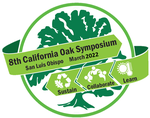#29

Spheres of Influence: Host Tree Proximity and Soil Chemistry Shape rRNA, but Not DNA, Communities of Symbiotic and Free-Living Soil Fungi in a Mixed Hardwood-Conifer Forest
Gabriel C. Runte*, Ecology, Evolution and Marine Biology, University of California, Santa Barbara
Alex H. Smith, Holly V. Moeller and Laura M. Bogar, Ecology, Evolution and Marine Biology, University of California, Santa Barbara
Host and symbiont diversity are inextricably linked across partnerships and ecosystems, with degree of partner reliance governing the strength of this correlation. In many forest soils, symbiotic ectomycorrhizal fungi coexist and compete with free-living saprotrophic fungi, with the outcomes of these interactions shaping resource availability and competitive outcomes for the trees aboveground. Traditional approaches to characterizing these communities rely on DNA sequencing of a ribosomal precursor RNA gene (the internal transcribed spacer region), but directly sequencing the precursor rRNA may provide a more functionally relevant perspective on the potentially active fungal communities. Here, we map ectomycorrhizal and saprotrophic soil fungal communities through a mixed hardwood-conifer forest to assess how above- and belowground diversity linkages compare across these differently adapted guilds. Using highly spatially resolved transects (sampled every 2 m) and well-mapped stands of varying host tree diversity, we sought to understand the relative influence of symbiosis versus environment in predicting fungal diversity measures. Canopy species in this forest included two oaks (Quercus agrifolia and Quercus douglasii) and one pine (Pinus sabiniana). At the scale of our study, spatial turnover in rRNA-based communities was much more predictable from measurable environmental attributes than DNA-based communities. And while turnover of ectomycorrhizal fungi and saprotrophs were predictable by the presence and abundance of different canopy species, they both responded strongly to soil nutrient characteristics, namely pH and nitrogen availability, highlighting the niche overlap of these coexisting guilds and the strong influence of aboveground plants on belowground fungal communities.
